
In an aquaculture setting, broodstock kingfish – which reach 1.7 metres in length and weigh more than 40 kilograms – must be knocked out before handling. The NIWA team drop a New Zealand-made anaesthetic called Acquiesce into the water, which puts the fish to sleep so they can be monitored for science or moved for tank cleaning. Photo: © Richard Robinson
Follow Our Changing World on Apple Podcasts, Spotify, iHeartRADIO or wherever you listen to your podcasts
Many of our fisheries are under pressure. At the same time people are eating more fish. Could farming iconic New Zealand species be the future? And what are the advantages of growing fish on land?
A new lease of life
Ocean Beach used to process lambs, a record of 20 000 in one day, but now it’s gullies and troughs run with seawater, not blood. Home to the New Zealand Abalone company and Manaaki Whitebait it’s become one the frontiers of New Zealand aquaculture – growing fish indoors.
Pāua puzzles and whitebait mysteries
It’s not an easy task. Growing fish on land means taking responsibility for their needs throughout their life cycle. First you must identify those needs, account for them in an indoor setting, and make the whole process as efficient as possible so you can still turn a profit. It takes trial and error, and patience.
Listen as Kate Evan’s travels the length of the country to learn how a new group of farmers are figuring out the puzzles of how to farm fish on land.

At Ocean Beach – the "Disney World of aquaculture" near Bluff – nearly a million young pāua cluster in dozens of tanks. Photo: © Richard Robinson
Learn more:
- Read the accompanying New Zealand Geographic article by Kate Evans, with photography by Richard Robinson.
- Listen to previous episodes of Voice of Tangaroa.
- Seaweed is also being farmed in a specialised warehouse space in Tauranga.
- Recently the green light has been given for an open ocean salmon farm in the Cook Strait.

Photo: NZ On Air
Voice of Tangaroa is a joint production between RNZ’s Our Changing World and New Zealand Geographic.
Reporting for this series is Public Interest Journalism funded through NZ On Air. You can learn more and read the articles for free at www.nzgeo.com/seas

